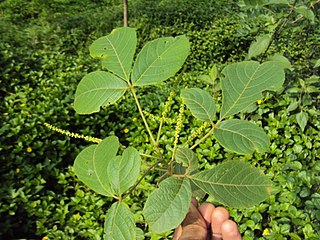Allophylus cobbe
| Titberry, Indian allophylus | |
|---|---|

| |
| Scientific classification | |
| Kingdom: | Plantae |
| Clade: | Tracheophytes |
| Clade: | Angiosperms |
| Clade: | Eudicots |
| Clade: | Rosids |
| Order: | Sapindales |
| Family: | Sapindaceae |
| Genus: | Allophylus |
| Species: | A. cobbe
|
| Binomial name | |
| Allophylus cobbe | |
| Synonyms[2] | |
|
List
| |
Allophylus cobbe, commonly known as titberry or Indian allophylus, is a pantropical, shrub in the family Sapindaceae with many uses in traditional medicine. It has a highly variable morphology throughout its range and may prove to be more than one species.
Description
The described size of Allophylus cobbe varies greatly from place to place. In Australia it is known as a small to large shrub, and "never a tree".[3] In India however it is described as a "shrub to small tree",[4] while in Papua New Guinea it is described as a tree "up to 25 m high".[5] The compound leaves are usually trifoliolate but may have from one to five leaflets.[5][6] The petiole may be from 2 to 11 cm (0.8 to 4.3 in) long, the petiolules of the leaflets up to 1 cm (0.39 in) long.[3][4][7] The leaflet blades are acuminate, obovate or elliptic, with pointed tips and cuneate bases, and the margins may be crenate towards the distal end.[3][4] The leaf surfaces vary from glabrous to tomentose[3][4]
Many small actinomorphic flowers to 2 mm (0.1 in) diameter are borne on a 2–16 cm (0.8–6.3 in) long inflorescence, which is racemose and may be branched or unbranched.[4][6] The resulting fruit are a glabrous red drupe measuring from 4 to 16 mm (0.2 to 0.6 in) in diameter, containing a single large seed.[3][4][5][7]
Taxonomy
This species was first described in Species Plantarum by Carl Linnaeus in 1753, who gave it the name Rhus cobbe.[8] It was later renamed Allophylus cobbe by William Forsyth Junior and published in Botanical Nomenclator in 1794.[9]
The wide variation in appearance of this species lead some to believe that it is polyphyletic and that the genus is in need of taxonomic revision.[3][6]
Distribution and habitat
Allophylus cobbe has a pantropical distribution, being found in tropical (and some subtropical) areas of Africa, Asia, Oceania and the Americas.[3][10]
It grows in monsoon forest, littoral forest and on the margins of mangrove forest, often on sandy soils. In Australia it is recorded at elevations from sea level to around 500 m (1,600 ft).[3][4][7][11]
Uses and ecology
Titberry has many uses in Ayurveda and other traditional medicine practices.[12] The plant has been used as a mouthwash and to treat ulcers and wounds, bone fractures, rashes, bruises, diarrhoea, fever and stomach ache.[3][4][13][14]
The timber has been used for roofing and firewood, and for making bows, rafts and fish traps. The fruits are edible, and can also be used as fish poison.[3][15][16]
This species is the host plant for the moths Cleora injectaria and Gonodontis clelia, and for the butterfly Nacaduba pavana singapura.[15][16]
Gallery
-
Fruits in QLD, Australia, April 2022
-
Flowers - QLD, Australia, April 2022
-
Leaves and flowers at Periya, India, 2014
-
Trifoliate leaves
References
- ^ "Species profile—Allophylus cobbe". Queensland Department of Environment and Science. Queensland Government. 2022. Retrieved 2 April 2022.
- ^ a b "Allophylus cobbe". Plants of the World Online. Royal Botanic Gardens, Kew. Retrieved 2 April 2022.
- ^ a b c d e f g h i j Reynolds, S.T. (2021). Busby, John R.; Kodela, P.G. (eds.). "Allophylus cobbe". Flora of Australia. Australian Biological Resources Study, Department of Agriculture, Water and the Environment: Canberra. Retrieved 2 April 2022.
- ^ a b c d e f g h Vattakaven Réjou-Méchain M, Muthusankar G, Ramesh B, Prabhakar, T; George, R; Balasubramanian, D; Réjou-Méchain, M; Muthusankar, G; Ramesh, B; Prabhakar, R (2016). "Allophylus cobbe". India Biodiversity Portal. Retrieved 4 April 2022.
{{cite web}}: CS1 maint: multiple names: authors list (link) - ^ a b c Conn, B.J.; Banka, R.; Lee, L.L. "PNG Trees". Plants of Papua New Guinea. Retrieved 4 April 2022.
- ^ a b c "Allophylus in Flora of China @ efloras.org". Flora of China. Missouri Botanical Garden, St. Louis, MO & Harvard University Herbaria, Cambridge, MA. Retrieved 3 April 2022.
- ^ a b c F.A.Zich; B.P.M.Hyland; T.Whiffen; R.A.Kerrigan (2020). "Allophylus cobbe". Australian Tropical Rainforest Plants Edition 8 (RFK8). Centre for Australian National Biodiversity Research (CANBR), Australian Government. Retrieved 2 April 2022.
- ^ "Rhus cobbe". International Plant Names Index (IPNI). Royal Botanic Gardens, Kew. 2021. Retrieved 4 April 2022.
- ^ "Allophylus cobbe". International Plant Names Index (IPNI). Royal Botanic Gardens, Kew. 2021. Retrieved 4 April 2022.
- ^ "Allophylus cobbe (L.) Forsyth fil". Global Biodiversity Information Facility. Retrieved 4 April 2022.
- ^ Cooper, Wendy; Cooper, William (2013). Australian Rainforest Fruits - A Field Guide. CSIRO Publishing. p. 477. ISBN 9780643107847.
- ^ "Allophylus cobbe". Medicinal Plant Names Services. Royal Botanic Gardens, Kew. Retrieved 5 April 2022.
- ^ Chavan, S.D.; Dias, R.J.; Magdum, C.S. (2019). "A Review on Medicinal Importance of Allophylus cobbe (L.) Raeusch and Garuga pinnata Roxburgh" (PDF). International Journal of Pharmacy and Biological Sciences. 9 (2): 1356–1362. ISSN 2230-7605. Retrieved 5 April 2022.
- ^ "Tit-berry". National Parks Board (NParks) of Singapore. Singapore Government. Retrieved 5 April 2022.
- ^ a b "Tit-berry (Allophylus cobbe)". Wild Singapore. Ria Tan. Retrieved 5 April 2022.
- ^ a b Beasley, John (2009). Plants of Cape York - the compact guide. John Beasley. p. 113. ISBN 978-0-9806863-0-2.
- CS1 maint: multiple names: authors list
- Articles with short description
- Short description matches Wikidata
- Nature Conservation Act least concern biota
- Articles with 'species' microformats
- Taxonbars with automatically added basionyms
- Taxonbars with 20–24 taxon IDs
- Allophylus
- Plants described in 1753
- Taxa named by Carl Linnaeus



